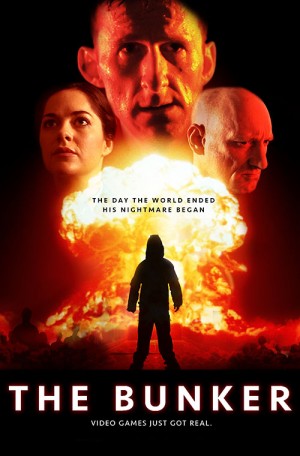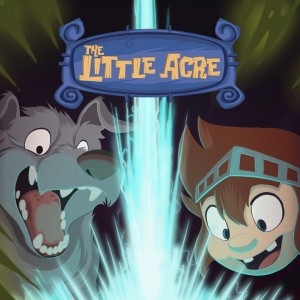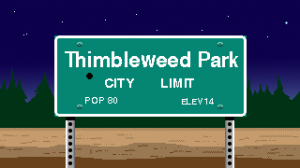Steve Gaynor – Tacoma interview
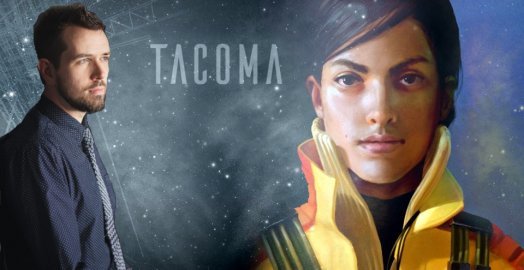
Before co-founding the Portland-based independent studio The Fullbright Company, Steve Gaynor worked on the acclaimed BioShock franchise for several years. Even after leaving the AAA space, Steve and his colleagues remained committed to the concept of environmental storytelling. However, for the studio’s critically acclaimed debut title Gone Home, Fullbright disentangled themselves from all action and RPG elements, while tightly connecting exploration with strong characterizations and a naturalistic family drama plot. As the developer’s second title Tacoma is about to be launched on PC and Xbox One in early August, I got hold of the game’ s writer and designer on Skype for an in-depth discussion. Read on as Steve shares plenty of game design insights, elaborates on why Fullbright's new explorational story game sends player to an evacuated space station seventy years in the future, and explains how Tacoma expands on the team’s previous work.
Ingmar Böke: Hi Steve, welcome to Adventure Gamers. It’s great to talk to you!
Steve Gaynor: Thank you!
Ingmar: Your new game Tacoma is about to be released. Please describe the story in your own words.
Steve: Sure! Tacoma is called Tacoma because it takes place on lunar transfer station Tacoma. The game takes place in 2088, and you have been sent to the station after the crew has been evacuated to recover the A.I. [artificial intelligence] that runs the station and return it to its owners. As you explore the station, you discover and interact with these kind of 3D recordings of moments that happened to the crew before you arrived. By doing that, you find out the story of what really led to their evacuation, why you were called there, what the A.I.’s role is in the events that led up to the present, and kind of unravel the mystery behind why you’re on the station in the first place.
Ingmar: So Tacoma not only has a totally different setting than Gone Home, it also takes place at a completely different point of time. What do these changes in terms of setting and time allow you to do when it comes to the game design?
Steve: You know, I guess there are a few different aspects of the sci-fi setting and the thought process behind it that went into what led us to that decision on Tacoma. One is that, with Gone Home we really focused on transporting the player into an era in the relatively recent past around 20 years ago, kind of recreating the feel of being in that time that we on the development team lived through and were familiar with. So we wanted to push ourselves to say, “okay, we can’t just rely on recreating an era; we want to go into a futuristic setting, so that we’re kind of forced to create more of the world, and to imagine more of the world than we would have if we had gone with a different historical period.”
Also, interactively, we wanted the player to be able to be more present for the moments in the story as they happened, but without saying, “okay, you’re really in a room with these characters,” as maybe something like The Walking Dead where you’re influencing what happens. It’s more like you’re an investigator who can kind of be there and observe these moments in real-time. But also, the way that’s relevant to the futuristic setting is that instead of them being ghosts or visions or something kind of fantastical in that sense, the way that you’re able to interact with these moments in Tacoma is through this augmented reality system that is integrated into the technology of the station you’re exploring. So basically, they’re these digital echoes of things that happened, and because they’re digital you’re able to move through them, and move the timeline of them, and manipulate them the way you would conceptually like a 3D video that’s surrounding you. That allowed us to make your relationship to these characters in these moments, and how you interact with him, and how you move through them, be a core mechanic of the game. So the futuristic setting basically allowed us to, you know, expand what we were doing, mechanically, with this kind of game.
Ingmar: I have read that you named Jordan Mechner’s The Last Express as one of the inspirations for Tacoma. Please elaborate on that.
Steve: Well, I think that there’s a few things that are relevant in The Last Express. The most straight forward one – or the most clear aspect – is that in The Last Express you’re kind of inside one continuous timeline that’s running through the course of the entire game. It’s basically in real-time, and you’re able to say, “okay, I was in my cabin, stayed there for this amount of time, then left and went to the dining car, and I saw this one thing happened there.” But either to solve a puzzle, to avoid getting caught or just to find more information, you can move back through time, back to when you were in your cabin, and take a different path.
 |
Steve Gaynor |
In Tacoma, generally, it’s less for traditional puzzle-solving, and it’s certainly not about avoiding a game-over state, but within each section of the station, each of the scenes that the characters are going through are kind of one big scene that spreads through the whole section. Much like in The Last Express, you can only be physically in one place at one time, but you can then say, “well, I was in the kitchen with these characters, and this happened, and then they left, so I’m going to move back where all those other characters were, rewind time to an earlier point in the scene, and see what they were doing before I met them. Now I can see all these angles of what was happening with the characters, what was happening in the story, by manipulating my position in space, and my position in the time of the scene, and knowing that those things can move independently of one another.”
I think that The Last Express is one of the few games that I’m aware of that really made that a central part of how you thought about your interaction with the game, and the story, and the events on screen. You know, I played that game when it came out, and…
Ingmar: Same here! A super-fascinating game.
Steve: Yeah, it’s a very interesting game! It came out in the late ‘90s, so it was kind of at that stage in ‘90s adventure games when I think games were getting more baroque and more ornate. So it’s exciting for us to be able to explore some of those similar concepts, and just apply them at a different time in game design. Do you know what I mean? (laughs) The stuff that’s there that I think didn’t get explored further because of where the genre was or where the industry was. So being able to say something that’s there can apply to what we’re doing – even though it’s not the exact same kind of game – is a really exciting opportunity.
Ingmar: How important is the aspect of zero-gravity in Tacoma?
Steve: Relatively speaking, there’s only a little bit of zero-gravity in the game. In an earlier version, there was a lot more of moving between different surfaces that you were attaching to, and kind of moving through zero-gravity to do that. At that point, we rebuilt the station to be constructed more like a centrifugal force station. Like a station in 2001, for instance, where the center of the station is zero-gravity, and the habitat spaces are connected by long arms that rotate to simulate gravity in the parts of the station where the crew would spend most of their time.
There are a few reasons why we wanted to do that. One was just a basic sense of plausibility, just this feeling of “oh yeah, I can see how people could really live in a space like this long-term” or “I can see how this might be how a company would build this space to support people living on it for years of their time.” But then, the other aspects of it are that in the earliest version of the game you were kind of always in zero-gravity but always not in zero-gravity, as in you were attaching to surfaces with magnetized boots. The world was in zero-gravity, but you couldn’t just free-float around. But, also, we couldn’t set up relatable environmental storytelling setups where people, like, left stuff on a table, you know, because things don’t stay on the table. I mean, we could have magnets on objects or whatever, but the immediacy of saying, “oh, I can see how this is where someone lived” is very different.
 |
Concept art by Rebecca Mock showing a ring-based station design |
So we built it so the center is zero-gravity, and you’re just floating, and then the wings are full-gravity, and that’s where people live. Along with being able to make the habitat spaces feel more immediate in that sense, it also gives us a stark contrast over the course of the game between, “oh, I’m floating; I really feel like I’m on a space station,” and “oh, now I’m walking, and it feels totally different, moving back and forth between those spaces.” Hopefully that gives you that feel of being on this facility in a way that’s really tangible, and that we don’t have to explain or focus on it further than you’re just, “I can feel what it would be like to be in this place,” which is cool for us.
Ingmar: You have mentioned 2001 as an example when it comes to the space station. What other influences can be found in its design? I’ve heard that you, for example, drew inspiration from visiting a submarine?
Steve: (laughs) Oh, yeah! That was something that we did early on just because we were thinking of, “what is an environment that’s sort of like where these people might have lived?” When we were working on Gone Home, we actually went and visited this turn-of-the-century mansion in Oregon, outside of Portland, which was of the time, and large and ornate, and that we could draw some details from, and get a feel for what being in that kind of space was like. Not being able to just visit a space station, we knew that at the local science museum here in town they have a submarine that is basically just docked and you can go on tours of it. Being in that space, and looking at how they designed living spaces, and habitat spaces for very tight quarters, and just having that immediate feel for what it would be like to be this boxed-in with this many people, and you’re stuck here, and you’re not getting off this thing for a long time, how does that affect your mindset?
 |
Though certainly more spacious, Tacoma's design was influenced by the team's visit to an actual submarine
|
The station in Tacoma is much more luxurious than a submarine as far as the footprint and everything. (laughs) But it has that similar feel of, “you’re living in a constructed space, and you’re living in this artificial space with these people that you’re doing a job with, but also you can’t get away from them.” So, the social dynamic is really about how you learn to live together, and work together, and kind of become a temporary family for each other without driving each other crazy, you know? (laughs)
Ingmar: You’re not only imagining how a space station could look in 2088, but also how the future could be like, and what has led to that particular future. Can you talk about that a little more or are we getting too deep into spoiler territory here?
Steve: No, I mean, I can certainly talk about it on some level. The reason that we set it in 2088 was to give ourselves a couple of generations ahead of us, so that we aren’t saying what’s going to happen in 20 years or what’s going to happen in 300 years. So we can kind of take our current reality as a jumping-off point for relatively immediate speculative-fiction. We’re going from our present, and saying, “where might this be leading?” and not saying everything that’s going to happen just continues on an unbroken ark forward. But also that what you see in our fictional universe, you can kind of look at our present reality or recent past and say, “oh, okay, I can see how what’s going on now or what people are theorizing might happen soon could lead to what’s happening in this fictional world.”
 |
Despite its futuristic sci-fi setting, there's still a sense of familiarity in Tacoma's technology and design
|
That’s most interesting to us, I think, because with Gone Home, we were like, “okay, we’re setting it in the ‘90s.” We were thinking of all the things that would have been in that time period, what would have been in the TV guide or whatever, being very direct with that. With Tacoma, we’re saying, “what’s happening now, what is it people think is going to be happening in the future, and how do we take that very concrete set of ideas, and the space that we’re in now, and abstract it in a way that’s hopefully interesting and surprising, and maybe goes to places that when you encounter it you don’t immediately think, “oh, yeah, that’s a really obvious idea.” But also, once you become familiar with it, hopefully there’s this feeling of, “I can see how this could be something that could happen. This is just one vision of the future that feels like it could make sense, and I feel like I’m in a real version of one path that our future could take.”
Ingmar: What were your inspirations as a writer when it comes to the sci-fi aspect of Tacoma?
Steve: The thing that we wanted to bring with us from Gone Home is that, through the futuristic and unfamiliar aspect of being on a space station, you can still really get to know these characters as individuals, and that you can feel like, “these are people I could imagine meeting” even though they’re in this totally science fiction-y setting, and they’re talking to an A.I. and everything. I think it’s that level of low-key, a little more naturalistic sci-fi that we’re really inspired by.
I mean, we go back to the dinner table scenes in the original Alien, where it was just a bunch of people having dinner. They’re on a space station, but they’re joking around, and you can imagine sitting at the table with them. Also like the Duncan Jones movie Moon that stars Sam Rockwell, and that is just about this one guy having to deal with passing time on this remote facility, and you have that feeling of, “this is just how a normal person in this situation would react to something that’s normal and every day to them, even though it’s not for us.” So, you know, those kinds of moments or those kinds of sci-fi pieces where you can get this feeling of, “it’s interesting to see what something that would be mundane to these people is like.” Familiarizing yourself with that, being like, “wait, why is this normal? Why aren’t they reacting to this differently? Oh, it’s because of this or that aspect of the world-building, the universe or the stuff that you’re discovering as you play.” So, that stuff is inspiring to us.
Ingmar: Speaking of characters, I noticed that one of them is named Roberta Williams. Seems like someone on your team must be a big fan. (both laugh)
 |
Crew member Roberta who??!
|
Steve: Yeah, for sure! You know, one thing is that for me, just as a writer, I sort of like it when a fictional character happens to have the same name as a real-world person. (laughs) It’s a little bit of a trope or whatever, but I think it’s fun, so I just wanted to do that.
But then, expanding from that, I hope that part of why what we do is interesting is because I feel like we have our feet equally in the lineage of classic adventure games, and in immersive first-person RPG Looking Glass-style games. I feel like both Maniac Mansion and System Shock are equally influential on me, and on our stuff. It was like, “if somebody on the crew has a known person’s name, who would it be?” And having that acknowledgment of the people that started what these kinds of games are – at this point so long ago – was something that I hope feels like a legit homage to one of the very earliest pioneers of adventure games.
Ingmar: After talking about pioneers, I’d like to move on to something very contemporary. The expression “ludo-narrative dissonance” is a pretty fancy thing in the gaming press these days…
Steve: (laughs) Yeah!
Ingmar: The BioShock series is just one example of many that often get mentioned within this context. Gone Home, on the other hand, feels like a perfect example of a game where story and interactivity are never in conflict. What’s your take on the whole subject?
Steve: I think that concept really arises from the fact that a lot of games are coming from a genre starting point, and mechanical elements of the genre are in conflict with other presentational or story or thematic elements being overlaid on them. I think you can see that in adventure games as well, where it’ll be like, “well, here’s this emotional and relatable story of this person, this place and now they’ll have to find three parts of whatever to unlock this weird door.” I think that there’s a lot of ways to address that, and in a lot of ways I think that there are aspects – especially of the original BioShock – that address that stuff well, and innovate those things, and then there’s aspects where they don’t feel like they align as well, and I think that’s kind of what the discussion surrounds.
 |
Gone Home bypassed common design conflicts by focusing almost exclusively on environmental storytelling |
I think that in the best cases, when you look at something like the first season of The Walking Dead or Gone Home, it’s a subtractive process. In BioShock, for instance, the stuff that was in conflict with each other was sort of like the mechanics of the game vs. the fictional presentation of the Little Sisters, or of how you upgrade yourself, or whatever. We had the luxury in Gone Home of saying, “there’s not gonna be combat, there’s not gonna be upgrades, there aren’t going to be complex or obscure puzzles.” It’s not one of those things where we say, “you’re going into this house, and it’s just a normal family’s house” and then the crazy uncle made this weird puzzle to unlock the door to the upstairs or something, so you’re like, “now this is about this super crazy puzzle designer uncle.” We were able to say, “if we just don’t have these elements, we can focus entirely on being there, finding things, living in this space, living with the story.” There’s just fewer individual elements to try to balance against one another.
I think when you look at what The Walking Dead did, it’s more of a traditional point-and-click adventure game-style adventure, but for the most part they were like, “if we take out the obscure puzzles, and if we really focus on moving to the environment, interacting with these characters, making these story decisions and being in this world” more so than, “how do I collect the three things to get to the next area.” It similarly tends to take you out of that headspace of “sometimes I’m in puzzle mode, and sometimes I’m in story mode,” or like, “sometimes I’m in kill-the-enemies mode, and sometimes I’m in emotional family drama mode.” It allows you to just say, “the fewer things that have to potentially be in conflict, the easier your job is of avoiding that kind of cognitive dissonance of trying to balance all those things in your head." (laughs)
Ingmar: When it comes to recent or current games, what games have particularly impressed you because of their storytelling qualities?
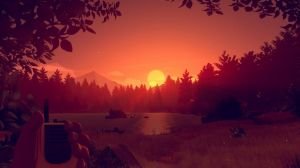 |
Campo Santo's Firewatch is a standout example of remote relationship-building
|
Steve: Well, let’s see. I mean, we’re friends with the folks at Campo Santo, and I thought that the feeling of building or navigating this relationship with this other character in real-time while you’re exploring the environment felt very innovative and exciting in Firewatch, but also you could totally see where the influences came from. It’s that interesting balance of, “it feels very new” even though, in practice, it’s like, “oh, yeah, you put this with this, and then you’ve got this new thing.” You know, as a designer, seeing that kind of cleverness is cool and inspiring, and as a player, it felt like a very fresh and legitimate experience that I hadn’t had before.
I also really liked the themes of the story content and the degree to which the developers were unfettered in addressing real issues in Night in the Woods, which I thought just had a fascinating perspective on, basically, people living in this small town that had been economically dying over the course of decades, and the characters’ openness in talking about class, and the difficulties of people living in this place, and religion, and faith, and these difficult aspects of maintaining friendships over time, and getting older. You know, all these issues that a lot of people, depending on your specifics, encounter in their own lives, but that games don’t have the space to talk about very much. It was really cool seeing those being addressed very directly!
I’m a big fan of a small studio called Turnfollow, who have only released their games on itch.io. They made a game called Little Party; it’s just about you playing as a mom that is at home while her teenage daughter has some friends over to have a party. That’s the whole premise, and you’re just kind of in that space, experiencing it. They also made a game called Packing Up the Rest of Your Stuff on the Last Day at Your Old Apartment. It’s a first-person game that is literally about packing up the last stuff in an apartment, putting it in boxes to move it out. But, you know, as you pick up things, each of them has a little bit of context connected to it that gives you this idea of who that character you’re playing is. It feels very relatable, small, and direct, and it’s really cool, so I would suggest checking out their games as well!
Ingmar: Sounds like games that might be right up my alley; I just scribbled down a note.
Steve: Cool! They’re small non-combat, non-puzzle story games that I think are really effective, and really well done, and feel unique. I like those games a lot, and I hope that Turnfollow will continue doing more rad stuff! (laughs)
Ingmar: Any recent games that you particularly liked because of their environmental storytelling?
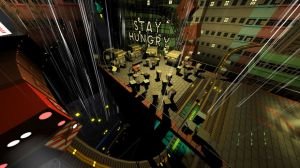 |
Steve cites Quadrilateral Cowboy's Brendon Chung as an important design influence for first-person story games
|
Steve: I’m trying to think about recent stuff because you can always be like, “there’s this one game from a long time ago,” but I mean, if your readers haven’t played Quadrilateral Cowboy by Brendon Chung… that came out last year and won the IGF awards [“best independent game”, “excellence in design”] at this year’s GDC. You know, Brendon Chung – to me – is just the master of environmental storytelling in the modern day. Thirty Flights of Loving is a huge influence, I think, on anybody who’s making first-person story games or, probably, first-person games at all these days. The core premise or the core mechanic in Quadrilateral Cowboy is that you’re using a laptop to hack different systems in these environments, but in between the hacking missions, it has these really intensely effective non-linguistic, purely environmental story scenes that are so well-done, and so pure.
Our games have a ton of language, and a ton of notes, and dialogue. I think that’s part of what we do and not a binary qualitative thing, but as a designer, and as someone who works in this space, I think there is this ideal of saying, “if just the environment of what you find could tell the whole story, that’s like sort of a holy grail kind of feeling.” And that’s what all of Brendon’s story stuff in Thirty Flights of Loving and Quadrilateral Cowboy is about. Quadrilateral Cowboy is amazing, so that is 100% worth looking into! For people who just want that environmental stuff, and say, “the hacking is not really what I’m here for, I just want more of that great Brendon Chung environmental storytelling stuff,” the game even allows them to skip past the hacking. (laughs)
Ingmar: Nowadays there is an enormous variety of very different games on Steam, and I guess every player can find something for his or her personal taste. For me as a gamer, that’s awesome. At the same time, I wonder what kind of outcome that huge number of releases is going to have in the long run. What do you think?
Steve: I guess it’s sort of two sides of the same coin. I think what’s really exciting about the direction that the game industry has gone in the last five to ten years is that development tools are more accessible to more people, so more people can be making games. The distribution methods are lower friction; you don’t have to be a publisher with a ton of money, and produce disks to go on store shelves. So all of that means that more games can be made and released and distributed, so we’re seeing more interesting, different stuff, which I think is really great.
The flipside of it is that there aren’t just a few dozen curated games being released on Steam every month; now there’s like hundreds or thousands of games being released. I think that that’s what Valve is trying to navigate, how to say, “we don’t want to be the arbiters that say that your game can’t be on Steam because we don’t want it there, but it could have been a big hit if we had let it on – or whatever, it might fail, but we don’t know whether that’s gonna be true or not; we don’t know what our audience wants.” There’s a lot of audiences on Steam now. And then the flipside of that being, if there is a small, lesser-known game that might appeal to me, how do I find out about it if it isn’t one of the games that Valve puts in front of me? So it’s a hard problem, and it can certainly – in theory – lead to something more like the iOS App Store, where you’re just like, “there’s 99% shovel ware on here; how do I know what is actually the good thing?” And most of the time, I think, on something like iOS it’s like you don’t even use the store to find stuff; your friends just tell you about things, right? (laughs)
Ingmar: That’s probably one of the easiest ways indeed.
 |
Before Gone Home, Steve worked on the Minerva's Den DLC for the highly-acclaimed BioShock 2
|
Steve: Yeah, and maybe that’s more of what Steam is now for things that aren’t the biggest titles on the platform, and maybe that’s fine. I think that there’s this tension between some developers and some players being like, “why are there all these thousands of titles to sort through on Steam? I just want to know what’s good!” I think it’s just a really hard problem between, “how do you host enough things that anybody who’s here might be able to find what they want even if it’s not the top-selling game of the month,” and also, “if I’m using their interface, how do I know what the stuff is?” Anyway, I don’t know, it’s one of those things that it would be great if there would be a perfect solution for it. (laughs) I think it’s more of a case of so many people are making so many games, and there’s so much possibility that one of those thousands of games – that wouldn’t have been getting made or getting distributed five years ago – is gonna be a huge hit. That’s probably worth figuring out how to make all that stuff accessible as opposed to having it really be as filtered-down as it used to be.
Ingmar: We’re recording this interview not long after the summer sale on Steam took place. Even a AAA production like Prey, which was released in early May, already had a discount of 34% during this sale. How much of a blessing, and how much of a curse are sales like this for you as an indie developer?
Steve: I think that they tend to be a really good thing. I think that there is more a kind of normalization going on. Valve used to say, “okay, there’s flash sales that only go on for a day or eight hours or whatever, and those are curated by Valve.” And so, it’s one of those things where if you [as a developer] were fortunate enough to be one of the titles that got picked for that, you could have a massive spike vs. if you weren’t featured at all, you would probably have hardly any pick-up during the sale whatsoever. Now the system is more like everybody gets to choose whatever discount they want, and some will be featured on the front page, but still, all the the titles are discounted for the whole sale, so it probably normalizes. If your game has visibility already, having a discount will help it a good amount, and if it doesn’t, maybe discounting your game can give you more visibility, but there isn’t as much of that massive differential between like, “oh, you got the eight-hour flash sale on Christmas morning? Well, lucky you, but nobody else has access to that.” So I think it’s one of those things where developers who have had that experience of, “I was a front page one-day discount in the Steam summer sale three years ago, and it was massive for us,” now say, “we don’t have that opportunity anymore.” The flipside is that almost nobody has ever had that opportunity, considering how big the library is on Steam. (both laugh)
There was a developer I was looking at who had a game that had come out within the last year, and they didn’t even discount their game at all during the Steam sale, but their unit sales quadrupled during the sale just because the Steam sale drives so many more people to the platform. Even if you don’t discount it, you get more people seeing your game, buying it and stuff. So, I think that the Steam sale in general gives people an excuse to engage with the platform. I think that’s an opportunity for all the titles to get more attention. As a developer, I’m at least glad to see that in the Steam sale this year for Gone Home, we discounted it by 75% and our sales did go up a lot. So it’s like during the Steam sale we can have the equivalent of six months of our general long-tail income come in all at once in that one month, and it doesn’t mean that nobody ever buys the game except when it’s on sale, but it does mean that you can have these nice pick-ups for old titles or a really huge spike for your new title being discounted for the first time or whatever. I think that, used wisely, it’s probably a good thing for developers and players.
Ingmar: Time has come for the final question: Let’s fast-forward time a bit… Tacoma has been released, and gamers were able to play and finish it. What’s your ideal of how they’ll describe the experience they’ve had?
Steve: As a player, I think that in a lot of ways there’s space for all sorts of games, and one kind of game that I want to play is one that is really just a great example of a genre that I love. The flipside of that is, I’m really excited to play something where I’m like, “I don’t feel like I’ve ever played a game like this before.” I think that Gone Home had that in a number of ways for a lot of players just because it was like, “wow, I’m just in this place with these characters, it’s like a really direct kind of emotional experience, and it’s about a subject matter that I don’t normally see.” So hopefully for at least some people there was this aspect of, “I haven’t played a game like this before.”
I hope that with Tacoma, there will be a similar reaction for different reasons. My ideal player reaction would be, “I’ve played this game, I didn’t know what to expect going into it, and the way that I interacted with the story, and the relationship I had with the story events, the characters, and the time, and how I moved through all that stuff was a way of telling a story in a video game that I hadn’t encountered before. That was exciting, cool, and interesting, and made me think about other possibilities of what could be done with this kind of thing.” And then also, hopefully, that the story they found with it was worth the experience in the end, and that they care about the characters, and that they’re surprised by what happens in the plot. All I’m hoping for is that people can play something that they feel is worth playing because it’s new, and it’s not quite something that is exactly like something they have played before, and that can feel at least a little bit inspiring to think about the possibilities that it points to. But, you know, we shall see. That’s my ideal player – hopefully somebody feels that way! (both laugh)
Ingmar: Thanks a lot for you time, Steve. It has been great talking to you, and I’m very much looking forward to playing Tacoma soon!
Steve: Awesome! It was great talking to you, too!






